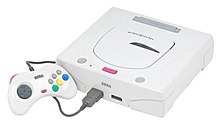
The PlayStation is a home video game console developed and marketed by Sony Computer Entertainment. It was released in Japan on 3 December 1994, in North America on 9 September 1995, in Europe on 29 September 1995, and in Australia on 15 November 1995. As a fifth-generation console, the PlayStation primarily competed with the Nintendo 64 and the Sega Saturn.

The Sega Saturn is a home video game console developed by Sega and released on November 22, 1994, in Japan, May 11, 1995, in North America, and July 8, 1995, in Europe. Part of the fifth generation of video game consoles, it was the successor to the successful Sega Genesis. The Saturn has a dual-CPU architecture and eight processors. Its games are in CD-ROM format, and its game library contains several ports of arcade games as well as original games.

The Dreamcast is a home video game console released by Sega on November 27, 1998, in Japan; September 9, 1999, in North America; and October 14, 1999, in Europe. It was the first sixth-generation video game console, preceding Sony's PlayStation 2, Nintendo's GameCube, and Microsoft's Xbox. The Dreamcast was Sega's final console; its 2001 discontinuation ended the company's eighteen years in the console market.

Radiant Silvergun is a shoot 'em up developed by Treasure. It was originally released in Japanese arcades in 1998 and subsequently ported to the Sega Saturn later that year. The story follows a team of fighter pilots in the far future who are battling waves of enemies summoned by a mysterious crystal dug up from the Earth. The player hosts an arsenal of six different types of shots to choose from, and a sword to destroy nearby targets. The stages are tightly designed to present players with scenarios that can be approached differently with the various weapon types.
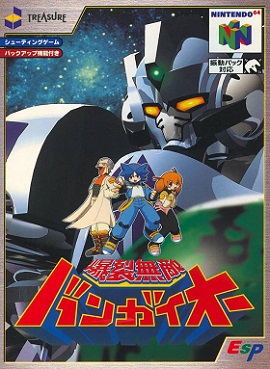
Bangai-O is a multidirectional shooter developed by Treasure and released in 1999 on the Nintendo 64 in Japan. It was ported to the Dreamcast worldwide shortly after with some gameplay changes and updated graphics and audio. The game places the player in control of a weaponized mech that can hover across large stages and fire at enemies all around them. The player must reach the end of each stage and defeat the boss, while avoiding hazards scattered across the map such as enemy mechs and gun turrets.

Treasure Co., Ltd. is a Japanese video game developer based in Tokyo known for its action, platform, and shoot 'em up games. The company was founded in 1992 by former Konami employees seeking to explore original game concepts and free themselves from Konami's reliance on sequels. Their first game, Gunstar Heroes (1993) on the Sega Genesis, was a critical success and established a creative and action-oriented design style that would continue to characterize their output. Treasure's philosophy in game development has always been to make games they enjoy, not necessarily those that have the greatest commercial viability.

Ikaruga is a shoot 'em up developed by Treasure. It is the spiritual sequel to Radiant Silvergun (1998) and was originally released in Japanese arcades in December 2001. The story follows a rebel pilot named Shinra as he battles an enemy nation using a specially designed fighter called the Ikaruga which can flip between two polarities, black and white. This polarity mechanism is the game's key feature and the foundation for its stage and enemy design. All enemies and bullets in the game are either black or white. Bullets which are the same color as the player are absorbed while the others will kill the player. The game features both single-player and cooperative modes.
The fifth generation era refers to computer and video games, video game consoles, and handheld gaming consoles dating from approximately October 4, 1993, to March 23, 2006. For home consoles, the best-selling console was the Sony PlayStation, followed by the Nintendo 64, and then the Sega Saturn. The PlayStation also had a redesigned version, the PSone, which was launched on July 7, 2000.

Lunar is a series of role-playing video games, developed by Game Arts in Japan and published in the United States by Working Designs, Ubisoft, and Xseed Games.
1998 saw many sequels and prequels in video games, such as F-Zero X, Marvel vs. Capcom, The Legend of Zelda: Ocarina of Time, Metal Gear Solid, Pocket Monsters: Pikachu, Resident Evil 2, Sonic Adventure, Street Fighter Alpha 3, The House of the Dead 2, Fallout 2 and Tomb Raider III, along with new titles such as Banjo-Kazooie, Dance Dance Revolution, Gex: Enter the Gecko, Half-Life, MediEvil, Parasite Eve, Radiant Silvergun, Spyro the Dragon, StarCraft and Xenogears. Earlier arcade video games such as Virtua Fighter 3 and Tekken 3 were also ported that year for home consoles.

Sega Ages is a series of video game ports, remakes, and compilations published by Sega. It consists of Sega arcade games and home console games, typically those for the Sega Genesis and Master System. The series was launched on the Sega Saturn in 1996. Entries were published for the PlayStation 2 as Sega Ages 2500, a reference to its bargain ¥2500 price point. The series later came to the Xbox 360 and PlayStation 3 as Sega Ages Online, and finally to the Nintendo Switch as simply Sega Ages. The name Sega Ages is a palindrome, with "Ages" being "Sega" backwards — this was previously used by Sega in European marketing strategies from the late 1980s to early 1990s.
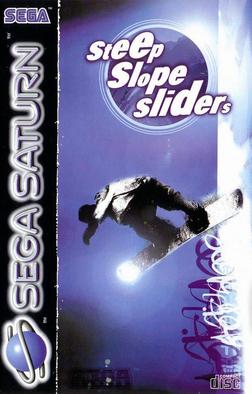
Steep Slope Sliders is a game that was made for the Sega Saturn and Sega Titan ST-V arcade system, published in 1997. It was developed by a collaboration of Victor Interactive Software, and the Cave Company. The game was released by Victor Interactive Software in Japan and by Sega in other territories. Capcom released the arcade version. The game was met with positive reviews, drawing favorable comparison to other snowboarding video games for its sharp graphics, innovative design, and intuitive control system.
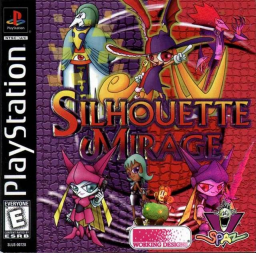
Silhouette Mirage is a 2D action side-scrolling video game developed by Treasure and released in 1997. The game's primary mechanic is the two opposing attributes, "Silhouette" and "Mirage" and the way they are able to cause damage to each other. Shyna features as the female protagonist who is able to switch between these attributes at will by facing either left or right on-screen. Secondary mechanics in the form of various melee moves are used to get enemies onto the correct side of the screen so that when Shyna is facing them, she is able to use the correct, opposing attribute to damage them.

Grandia is a role-playing video game, developed by Game Arts and published by Entertainment Software Publishing for the Sega Saturn console as the first game in their Grandia series. Released in Japan in 1997, the game was ported to the PlayStation in 1999, with an English version of the game appearing on the platform in North America in the following September by Sony Computer Entertainment, and in Europe in 2000 by Ubisoft. The game was produced by much of the same staff who worked on the company's previous role-playing endeavor, the Lunar series, including producer Yoichi Miyagi and composer Noriyuki Iwadare.
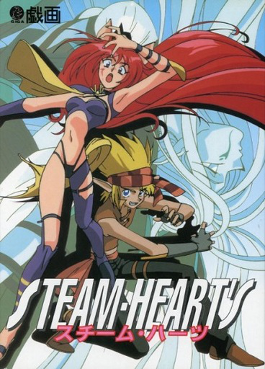
Steam-Heart's is a shoot 'em up and eroge developed by Giga and published by TGL. The story follows two siblings as they fight off a virus that is possessing the people in their world. The game features shooter gameplay paired with ample erotic cutscenes with scantily clad women. Steam-Heart's was initially released on PC-98 personal computers in 1994. It later made its way to the PC Engine Super CD-ROM² System in 1996 and then the Sega Saturn in 1998. All releases have been limited to the Japanese market. Critics generally found the gameplay to be average, with the erotic content being the sole distinguishing feature.

Thunder Force V is a 1997 Japanese side-scrolling shooter video game developed by Technosoft for the Sega Saturn. It is the fifth game in the Thunder Force series. Unlike previous games in the series, Thunder Force V uses polygons to model the larger enemy ships and some of the scenery, in addition to sprites. In 1998, Thunder Force V was ported to the PlayStation as Thunder Force V: Perfect System.

Bangai-O Spirits is a shoot 'em up for the Nintendo DS, and the sequel to Bangai-O which was released on the Nintendo 64 and Dreamcast. A sequel, Bangai-O HD: Missile Fury, was released in 2011.

Sega Corporation is a Japanese multinational video game and entertainment company headquartered in Shinagawa, Tokyo. Its international branches, Sega of America and Sega Europe, are headquartered in Irvine, California and London, respectively. Its division for the development of both arcade games and home video games, Sega Games, has existed in its current state since 2020; from 2015 to that point, the two had made up separate entities known as Sega Games and Sega Interactive Co., Ltd. Sega is a subsidiary of Sega Sammy Holdings. From 1983 until 2001, Sega also developed video game consoles.


